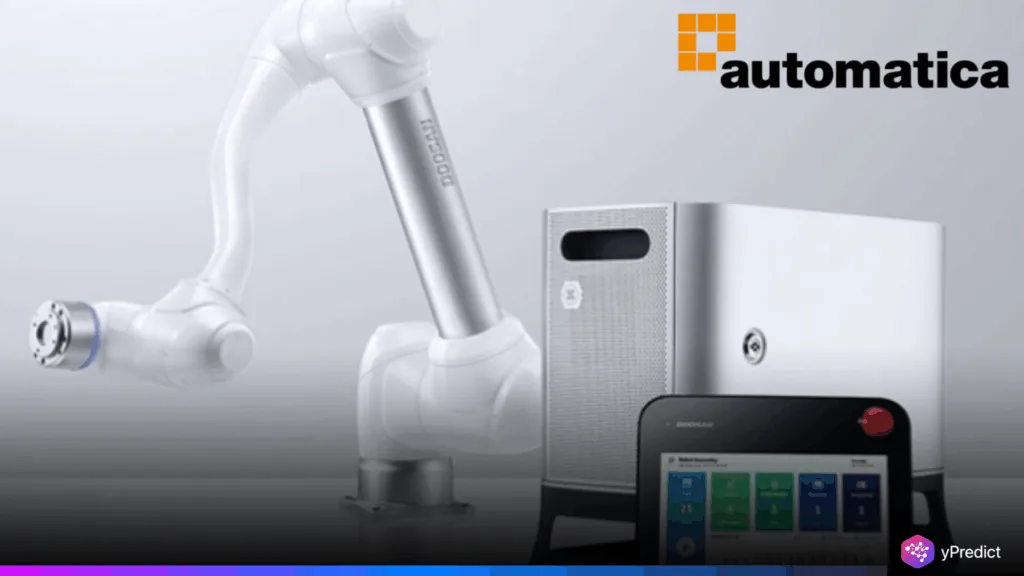
Doosan Robotics will showcase its largest-ever portfolio of AI-integrated automation solutions at Automatica 2025 in Munich, beginning June 24. Under the theme “AI Robot Solution,” the company’s exhibition is split into two zones. ‘Automation to Reality’ and ‘Automation in Action’, featuring breakthrough robotics powered by artificial intelligence, vision systems, and real-time simulation. Collaborations with NVIDIA and AWS underpin several offerings. Including robots capable of interpreting voice commands, handling materials autonomously, and executing tasks learned via simulation. These advancements underscore Doosan’s move toward intelligent manufacturing systems. That eliminates the need for manual programming or retraining, reflecting a major shift in how AI is applied in industrial robotics.
‘Automation to Reality’—Where ’AI Robots Learn and Act Like Humans
In the ‘Automation to Reality’ zone, Doosan presents its most sophisticated AI robot yet. The “Voice to Real” system, built with AWS, uses voice recognition, 3D vision, and intent understanding to let users give everyday commands to robots. Upgraded from its CES 2024 debut, this collaborative robot autonomously locates and manipulates objects based on spoken input, demonstrating true human-machine interaction. Doosan’s Material Handling Solution utilizes its Multi-Arm Dynamic Manipulation Engine. Enabling three robotic arms to perform simultaneous, complex object handling with no prior training. Vision AI and real-time adaptation allow these systems to execute highly precise tasks in unpredictable environments.
The Sanding Solution applies AI to analyze surfaces and perform delicate polishing autonomously, while the Inspection Solution uses 3D scanning and machine learning to inspect vehicle exteriors for defects in real time. One standout innovation is “Sim to Real,” combining NVIDIA Isaac Sim and CuRobo. This platform simulates robot motion in NVIDIA Omniverse, leveraging GPU acceleration for ultra-fast trajectory planning. Real-time feedback ensures that simulated actions match physical robot behavior without latency or recalibration. Together, these solutions blur the line between digital simulation and real-world performance, offering manufacturers scalable AI systems that learn, adapt, and operate with minimal human input.
‘Automation in Action’ – AI-Powered Robots at Work Across Industries
In the ‘Automation in Action’ zone, Doosan Robotics demonstrates practical, AI-enhanced robotics applications deployed in real manufacturing environments. These include smart systems for welding, machine tending, assembly, inspection, and palletizing, each developed with European automation partners. Robots in this zone apply AI not just for task execution but for process optimization. For example, vision systems guide robots in assembly, allowing them to adjust dynamically to variations in parts. Palletizing robots analyze product sizes and weights in real time to maximize spatial efficiency. Welding systems employ predictive AI to adjust parameters based on material conditions and joint types.
These solutions are already implemented in such global corporations as General Motors, Heineken, Danone, and Royal Mail. This demonstrates the increasing business feasibility of AI. The associated technology is tailored according to the requirements of European production. Which is frequently concentrated on flexibility, safety, and adaptability. With the help of machine learning models, Doosan robots become smarter with time and are able to optimize the routes, shorten the downtime, and avoid quality problems before they happen. The growing focus on collaborative robotics can also be seen as part of an industry shift towards human-AI cooperation. Where machines take over routine activities or tasks that are unsafe for humans, and human-controlled tasks that would require complex decision-making.
Strategic AI Partnerships Push Doosan Robotics Ahead
The teamwork between Doosan, NVIDIA, and AWS is the focus of its AI jump. Such voice-interactive robots are powered by AWS and cloud-based control systems. This leads to a collection of robots that can learn through simulations, understand human speech, and operate without prior programming. These alliances enable Doosan to ramp up the implementation of AI in manufacturing and logistics, which require reliability, rapidity, and flexibility. With the increased global demand for intelligent automation, Doosan has chosen its model, the combination of AI and highly advanced hardware and real-time learning, which makes it one of the forces behind the smart factory and the use of artificial intelligence in production.






